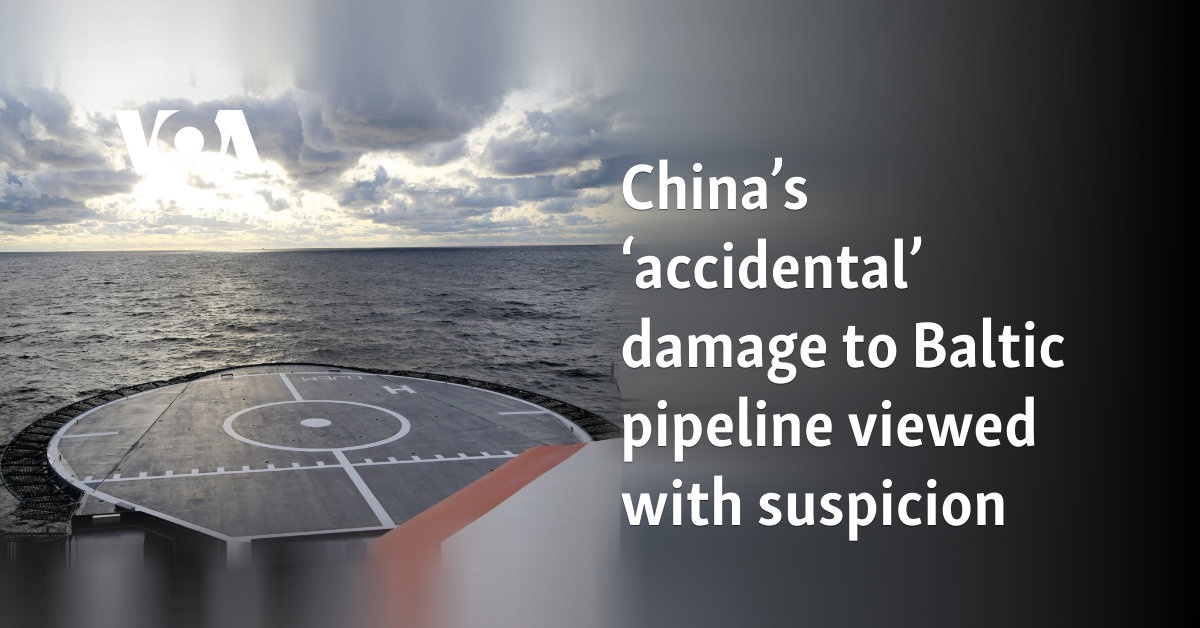Western politicians and analysts are suspicious of Beijing’s admission this week that a Chinese container ship damaged the Baltic Connector – a vital Baltic Sea gas pipeline between Estonia and Finland – in October.
The South China Morning Post reported on August 12 that the Chinese government had informed Finland and Estonia 10 months after the incident that it had been carried out by a Hong Kong-registered vessel named Newnew Polar BearHowever, he blamed a storm for the alleged accident.
In an interview with Estonia’s public broadcaster ERR on August 13, Estonian Defense Minister Hanno Pevkur said he was skeptical of China’s claim that a storm caused the incident.
“For me personally, it is very difficult to understand how a ship’s captain could not notice for so long that his anchor was dragging on the seabed. However, it is the task of the public prosecutor’s office to complete the investigation,” he said.
Markku Mylly, the former director of the European Maritime Safety Agency, told local media in Helsinki that there were no storms in the Gulf of Finland at the time. The Finnish newspaper Iltalehti consulted data from the Finnish Meteorological Institute and confirmed that Mylly’s memory was correct.
Pevkur told ERR that Estonia would not give up its compensation claims against China.
The oil and gas pipeline through the Baltic Sea, built with EU support, was put into operation in 2019 at a total cost of around $331 million to free Finland and the three Baltic countries Estonia, Latvia and Lithuania from their dependence on Russia for natural gas supplies.
The pipeline was the source of almost all of Estonia’s natural gas supply after the Russian invasion of Ukraine in 2022 triggered European restrictions on imports of Russian gas. Following the damage, Estonia temporarily had to rely on Latvia for natural gas supplies.
The pipeline was reopened for commercial use in April after repairs costing about $38 million, a senior vice president of Gasgrid Finland told the Associated Press. Some telecommunications cables were also damaged in the incident.
Following the incident, Finnish and Estonian investigators recovered the ship’s six-ton anchor from the seabed near the damaged pipeline and tracked it to the ship. They attempted to contact it, but the ship did not respond.
The damage came at a time of heightened tensions between Europe and Russia over sanctions against Moscow for its invasion of Ukraine, and critics suspected it was a deliberate act of sabotage by Russia or its ally China.
After the pipeline was damaged Newnew Polar Bear first sailed to St. Petersburg and Archangelsk in Russia and later docked in the Chinese port of Tianjin.
Eoin Micheal McNamara, a global security expert at the Finnish Institute of International Affairs, told VOA that Finns doubt Beijing’s claim that the ship’s damage to the pipeline was an accident.
“Elsewhere in the Nordic-Baltic region, underwater infrastructure has also been damaged by ‘man-made activities’ in recent years. For example, there were acts of sabotage on the Nord Stream in 2022 and the severing of a data cable between Norway and its Arctic island of Svalbard before that,” said McNamara. “As geopolitical tensions increase, more targeted acts of sabotage are expected.”
German media reported this week that investigators had asked Poland to arrest a Ukrainian diving instructor who was part of a team that blew up the Nord Stream gas pipelines in the Baltic Sea that delivered Russian gas to Europe. Russia blamed Britain, Ukraine and the United States for the sabotage, which they denied.
McNamara said there were suspicions that Russia was involved in damaging the Balticconnector pipeline. “Plausible deniability is a central tenet of hybrid interference. There are suspicions that the use of a Hong Kong-registered vessel was a tactic to achieve that plausible deniability,” he said.
Russian President Vladimir Putin last year dismissed as “nonsense” the idea that Russia could be behind an attack on the pipeline.
Estonia and Finland are still jointly investigating the ship, which belongs to China’s NewNew Shipping Company.
The Estonian prosecutor leading the investigation said that under international law, China’s statement that the ship caused the damage could not be used as evidence in a criminal investigation because China had not invited Estonian criminal investigators to participate in Beijing’s own investigation.
VOA contacted the Chinese Foreign Ministry about the matter, but was referred to the Chinese Maritime Administration.
Chinese Foreign Ministry spokesman Lin Jian said at a press conference on August 13: “China is pushing forward the investigation in accordance with the facts and the law and is in close contact with relevant countries. It is hoped that all parties will continue to push forward the investigation in a professional, objective and cooperative manner and jointly ensure that the incident is handled reasonably.”
Finnish Foreign Minister Elina Valtonen told VOA in an email: “We are constantly cooperating with China and exchanging information on this matter, but will not go into details as the investigation is still ongoing.”
The Finnish National Bureau of Investigation (NBI), which is investigating the case, told VOA that Finnish and Estonian authorities are cooperating with Chinese authorities on the matter. The NBI said it will publish the results with the Estonian side as early as autumn.
“Based on the evidence collected and information analysed during the investigation, it can be concluded that the sequence of events is considered clear and there are sufficient grounds to suspect that the container ship Newnew Polar Bear is related to the damage. The cause of the damage appears to be the anchor and anchor chain of the vessel in question, which are damaged.”
The NBI added: “It must be noted that the investigation is still ongoing and final conclusions on what is behind these incidents (technical failure – negligence, poor seamanship – intentional act) cannot be reached until all necessary investigative measures are completed, and that will take some time.”
VOA’s Adrianna Zhang contributed to this report. Some information was provided by Reuters.

